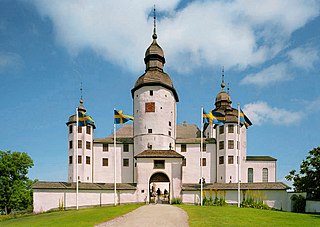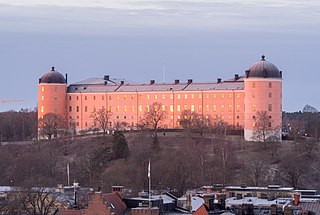
Baron Gabriel Gustafsson Oxenstierna was a Swedish statesman.
Nils Jönsson Oxenstierna (1390s–1450s) was a Swedish nobleman. During the Kalmar Union, he was co-regent of Sweden, together with his brother Bengt Jönsson Oxenstierna (1390s–1450s) from January to June 1448. He was a member of the Privy Council of Sweden in 1432, Castellan (hövitsman) at Borgholm Castle in 1436, Stäket in 1438, and Nyköping Castle in 1442. Dubbed as knight by King Christopher of Bavaria following his coronation in 1441.

Count Gustav Horn af Björneborg was a Finnish nobleman of the Swedish Empire, military officer, and Governor-General. He was appointed member of the Royal Council in 1625, Field Marshal in 1628, Governor General of Livonia in 1652 and Lord High Constable since 1653. In the Thirty Years' War (1618–1648), he was instrumental as a commander in securing victory at the Battle of Breitenfeld, in 1631. He was High Councillor of the realm in 1625, elevated to the rank of field marshal in 1628, and sometimes commander-in-chief of Swedish forces in Germany during Thirty Years' War. After the war, he served as Governor-General of Livonia 1652, President of War department and Lord High Constable in 1653. In 1651, Queen Christina created him Count of Björneborg.

Stockholm Palace or the Royal Palace is the official residence and major royal palace of the Swedish monarch. Stockholm Palace is on Stadsholmen, in Gamla stan in the capital, Stockholm. It neighbours the Riksdag building. The offices of the King, the other members of the Swedish royal family, and the Royal Court of Sweden are here. The palace is used for representative purposes by the King whilst performing his duties as the head of state.

The Drottningholm Palace is the private residence of the Swedish royal family. Drottningholm is near the capital Stockholm. Built on the island Lovön, it is one of Sweden's Royal Palaces. It was originally built in the late 17th century, and it served as a regular summer residence of the Swedish royal court for most of the 18th century. Apart from being the private residence of the Swedish royal family, the palace is a popular tourist attraction.

Buda Castle is the historical castle and palace complex of the Hungarian Kings in Budapest. It was first completed in 1265, although the massive Baroque palace today occupying most of the site was built between 1749 and 1769. The complex in the past was referred to as either the Royal Palace or the Royal Castle. The castle now houses the Hungarian National Gallery and the Budapest Historical Museum.

Skokloster Castle is a Swedish Baroque castle built between 1654 and 1676 by Carl Gustaf Wrangel, located on a peninsula of Lake Mälaren between Stockholm and Uppsala. It became a state museum in the 1970s and displays collections of paintings, furniture, textiles and tableware as well as books and weapons that amount to 20,000 items.

Läckö Castle is a medieval castle in Sweden, located on Kållandsö island on Lake Vänern, 25 kilometers north of Lidköping in Västergötland, Sweden.

Uppsala Castle is a 16th-century royal castle in the city of Uppsala, Sweden. Throughout much of its early existence, the castle played a major role in the history of Sweden. Originally constructed in 1549, the castle has been heavily remodeled, expanded, and otherwise modified. Today the structure houses the official residence of the governor of Uppsala County, various businesses, and two museums.

The Chinese Pavilion, located in the grounds of the Drottningholm Palace park, is a Chinese-inspired royal pavilion originally built between 1753 and 1769. The pavilion is currently one of Sweden's Royal Palaces and a UNESCO World Heritage Site.

Övedskloster Manor is a manor in Sjöbo Municipality, Scania, in southern Sweden.

Haga Castle is a castle by Lake Mälaren outside of Enköping in Uppsala County, Sweden.

Rosersberg Palace is one of the Royal Palaces of Sweden. Situated on the shores of Lake Mälaren, on the outskirts of Stockholm, it was built in the 1630s by the Oxenstierna family and became a royal palace in 1762, when the state gave it to Duke Karl, the younger brother of Gustav III of Sweden.

Bollerup is a castle in Tomelilla Municipality, Scania, in southern Sweden.

Örbyhus Castle is a castle in Tierp Municipality, Sweden. It lies some 12 kilometres east of European route E4, approximately halfway between Uppsala and Gävle.

Sturehov Manor is a manor house in Botkyrka Municipality, a suburb of Stockholm, Sweden. The manor contains well-preserved 18th-century interiors.

Stegeborg Castle is a ruined castle in St Anna parish, Söderköping, Östergötland, located on an island in a narrow sound at the bay of Slätbaken.

University Hall or the University Main Building is the main building of Uppsala University in Uppsala, Sweden. The building is situated in University Park close to Uppsala Cathedral. It was designed in Italian renaissance Beaux-Arts style by architect Herman Teodor Holmgren (1842-1914) and completed in 1887.
The Embassy of Sweden in Algiers is Sweden's diplomatic mission in Algeria. The first Swedish ambassador was accredited to Algiers in 1963. The ambassador since 2021 is Björn Häggmark.




















